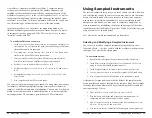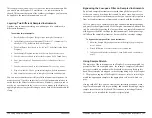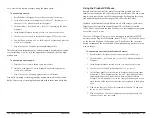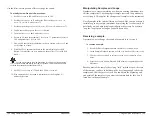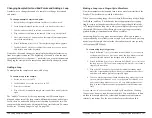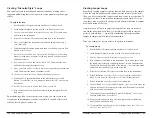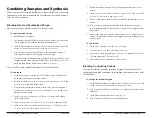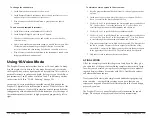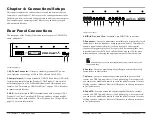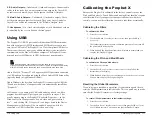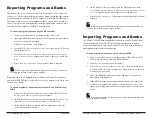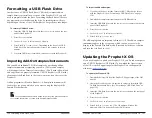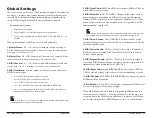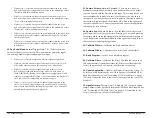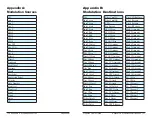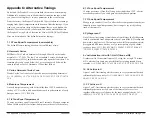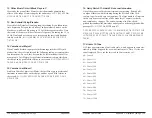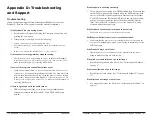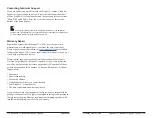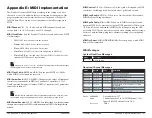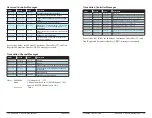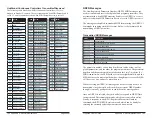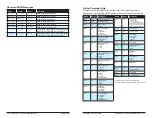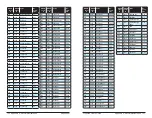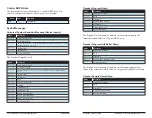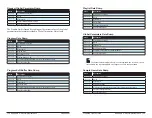
124
125
Sequential
Prophet X User’s Guide
Global Settings
Global Settings
For example, if you set the base
midi
channel
to 1, Layer A (voices 1-4)
will respond to MIDI channel 1 and Layer B (voices 5-8) will respond to
MIDI channel 2. In 16-voice mode, the base channel controls voices 1-8
and the other channel controls voices 9-16,
13 . Local Control:
Off, On. Key/Wheels Off—
When on (the default),
the keyboard and front panel controls directly affect the Prophet X.
When off, the controls are transmitted via MIDI but do not directly
affect the “local” synth (that is, the Prophet X). When
key
/
wheels
off
is selected the front controls are enabled (so that you can edit them) but
the keyboard and pitch/mod wheels are off. This is primarily useful for
avoiding MIDI data loops that can occur with some external sequencers.
14 . Velocity Curve:
Curve 1... Curve 8—
Sets one of the eight velocity
curves for the keyboard to adjust the velocity response to your playing style.
15 . Pressure Curve:
Curve 1, Curve 2, Curve 3, Curve 4—
Sets one of four
pressure curves for the keyboard to adjust the aftertouch to your playing style.
16 . B Outputs:
On, Off—
Setting this parameter to
on
sends the audio
output of Layer B of stacked or split sounds to the
b
output
jacks on
the rear panel. This is useful if you want to amplify, mix, or externally
process Layer B separately from Layer A.
17 . Mono/Stereo:
Stereo, Mono—
The Prophet X defaults to stereo
operation. When set to Mono, this parameter defeats all pan settings and
modulation, effectively making each of the outputs a mono output.
18 . Pot Mode:
Relative, Passthru, Jump—
The rotary controls on the
Prophet X’s front panel are a mixture of “endless” rotary encoders and
potentiometers or “pots.” The pots are identifiable by their lined knobs
and limited amount of travel. There are three pot modes to determine
how the synth reacts when the programmable parameters are edited.
(Master volume is not programmable, so these modes don’t apply.)
When set to
relative
, changes are relative to the stored setting. In Rela-
tive mode, the full value range is not available until either the minimum
or maximum value and the respective lower or upper limit of the pot’s
travel is reached.
For example, the Resonance parameter has a value range of 0 to 255.
Let’s say the physical position of the Resonance pot is the equivalent of
a value of 100. If you switch to a program that has a stored Resonance
setting of 63 and turn the pot all the way up, it will only go to 90. To get
to the maximum value of 255, you first have to turn down until the value is
at the other extreme and the pot is at the limit of its travel (in this case, 0
and fully counter-clockwise, respectively).
In
passthru
mode, turning the pot has no effect until after the edited
value equals the preset value (that is, until the edited value “passes
through” the stored value).
jump
mode uses an absolute value based upon the position of the pot
when edited: turn a pot and the value jumps immediately from the stored
value to the edited value.
19 . Alt Tuning:
Equal Temperment, 1…17—
Selects one of the Prophet X’s
built-in tunings. Set to
1.
equal
temperment
, the tuning is standard, chro-
matic tuning. Choosing 2 through 16 selects an alternative, non-chromatic,
non-Western scale that can be used to emulate ethnic instruments or in other
creative ways. See “Appendix C: Alternative Tunings” on page 132 for a
description of each tuning. Additional tunings can be imported as a SysEx
message.
20 . Screen Saver:
On, Off—
The Prophet X display has a built-in screen
saver that puts it to sleep when not in use. This features is designed to
prolong the life of the display and we recommend using it. If, however,
you want to disable this feature you can do so by setting it to
off
.
21 . Filter Pedal Mode:
Breath CC2, Foot CC4, Exp CC11, LPF Full,
LPF Half—
Selects the destination for pedal data received on the rear-
panel
filter
jack. This allows you to use an expression pedal connected
to this jack for either its default operation of controlling filter cutoff, or
to control the amount of modulation sent to a destination chosen within
the modulation matrix (via the pedal connected to this jack).


